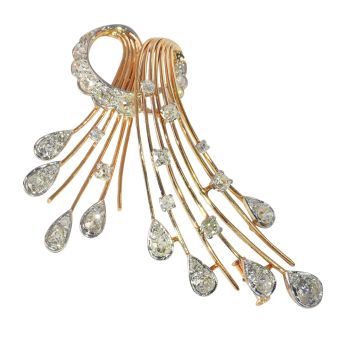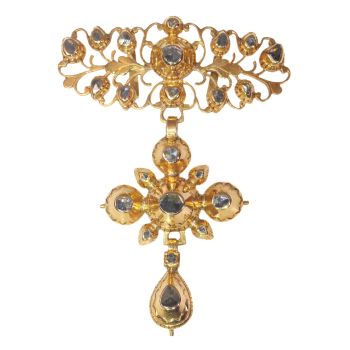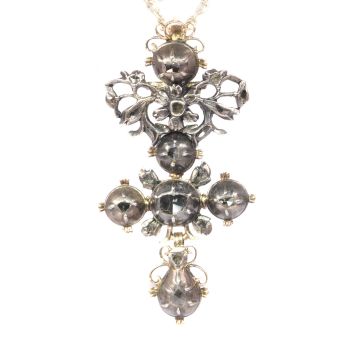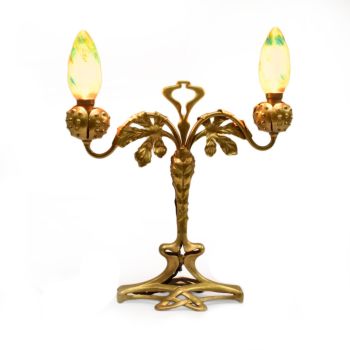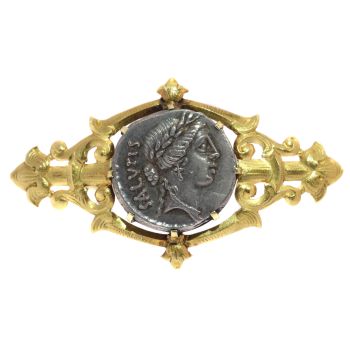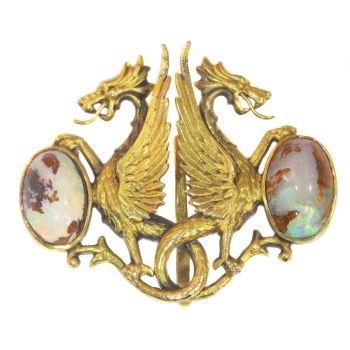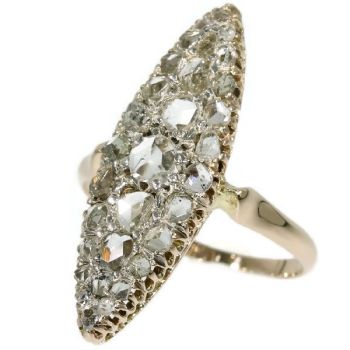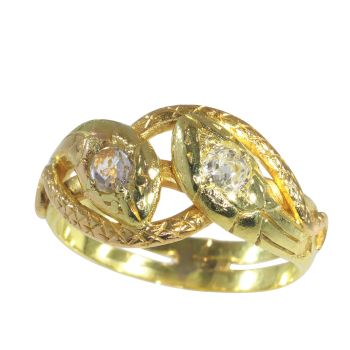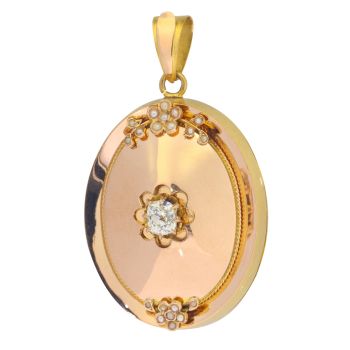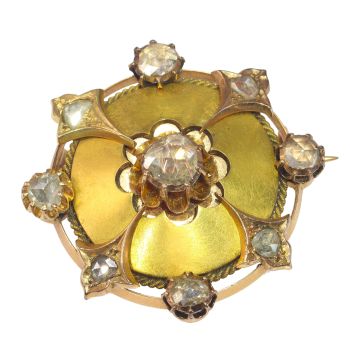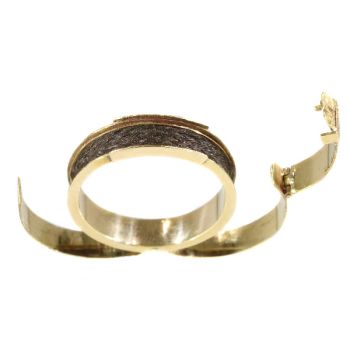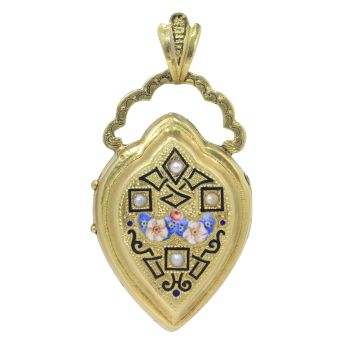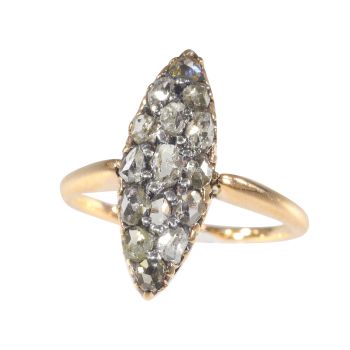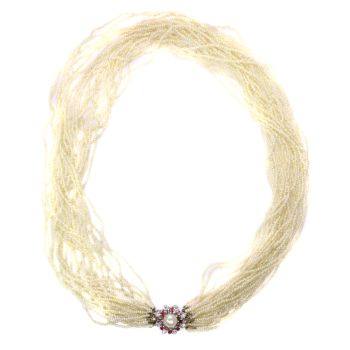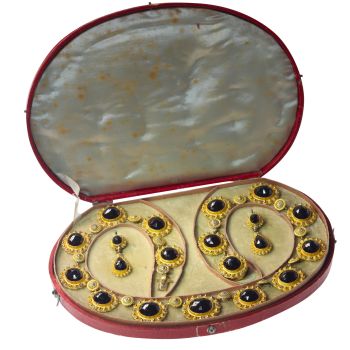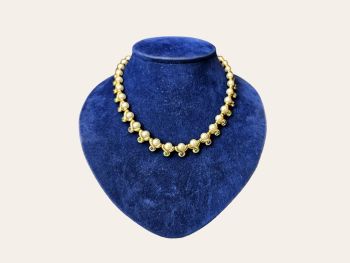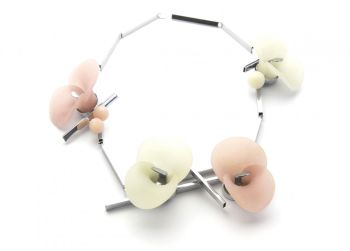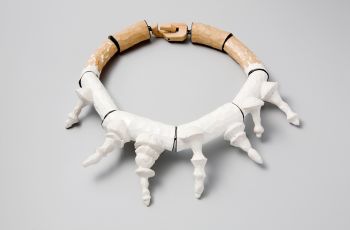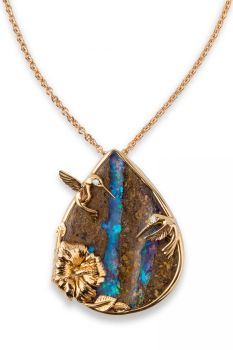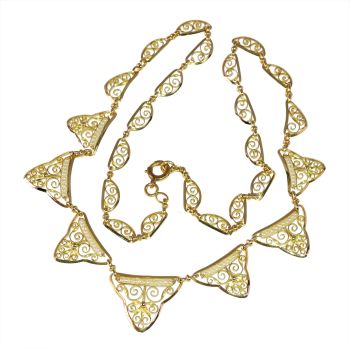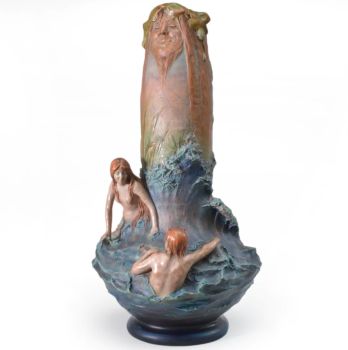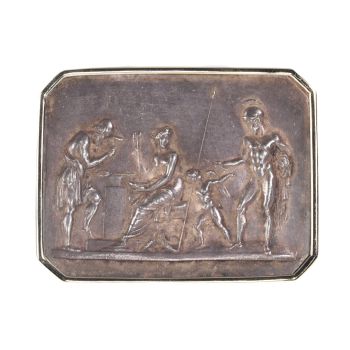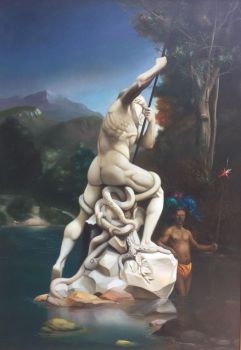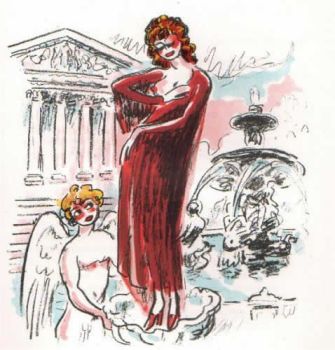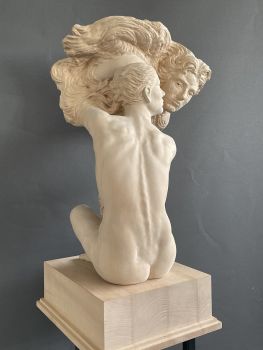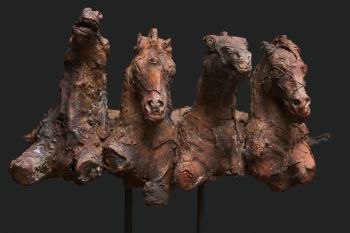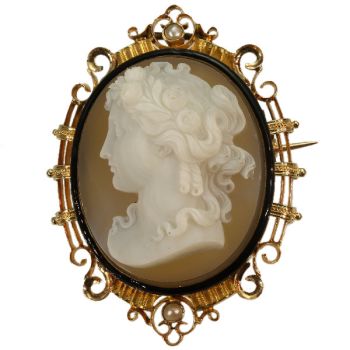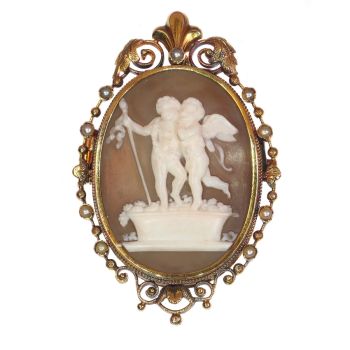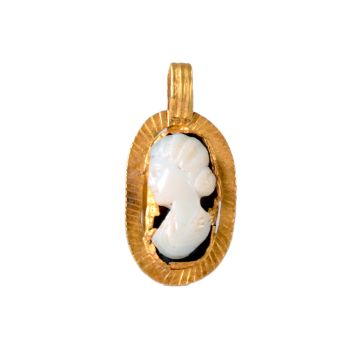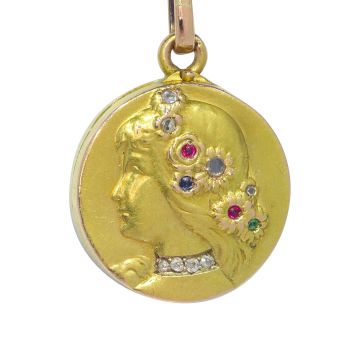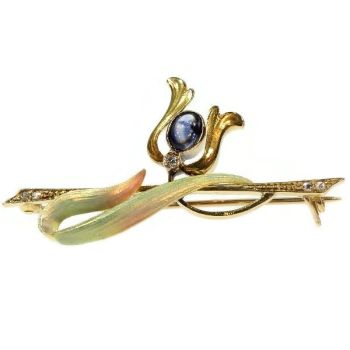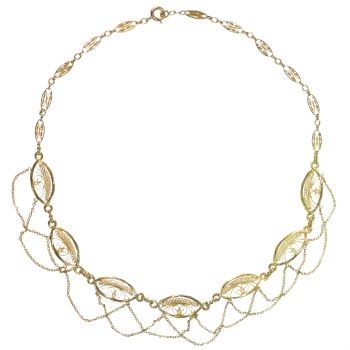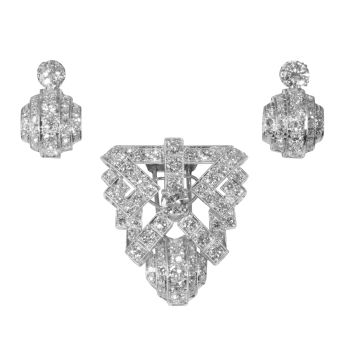Victorian Cameo Necklace, Circa 1860 – A Grand Tour Masterpiece in Gold 1860
Onbekende Kunstenaar
Cameo
€ 21.500
Adin Fine Antique Jewellery
- Over kunstwerk
A magnificent Victorian cameo necklace, circa 1860, featuring twelve intricately carved shell cameos, each a window into mythology and allegory. Connected by delicate 14K red gold chains, the cameos depict classical scenes—gods, muses, and nymphs—drawnfrom Greco-Roman traditions. Rich in symbolism, the detailed artistry conveys stories of love, pursuit, and divine encounters, each moment frozen in luminous relief. Likely inspired by the Grand Tour, this piece reflects the cultural fascination of19th-century travellers, combining romance, artistry, and history. A timeless treasure, it offers a tangible connection to an era enamoured with beauty and classical antiquity.
Antique jewelry object group
necklace
Condition
very good condition
more info on our condition scale
Country of origin
The origin of this jewel cannot be definitively determined due to the absence of hallmarks.However, such pieces were commonly purchased in Italy during the 17th till 19th centuries by travellers undertaking the Grand Tour. The Grand Tour was a traditional journey through Europe undertaken by wealthy young men of the aristocracy and upperclasses from the 17th to the early 19th centuries. Its purpose was both educational and cultural, offering travellers the opportunity to experience the art, architecture, and antiquities of classical antiquity and the Renaissance. Italy, renowned for its cultural treasures, was a key destination, and many travellers brought back souvenirs such as jewellery, sculptures, and other artefacts as mementoes of their journey.
Style
Victorian - Victorian decorative arts refers to the style of decorative arts during the Victorian era. The Victorian era is known for its eclectic revival and interpretation of historic styles and the introduction of cross-cultural influences from themiddle east and Asia in furniture, fittings, and Interior decoration. Victorian design is widely viewed as having indulged in a regrettable excess of ornament. The Arts and Crafts movement, the aesthetic movement, Anglo-Japanese style, and Art Nouveaustyle have their beginnings in the late Victorian era.
See also: Victorian
more info on styles
Style specifics
The Grand Victorian Period - Experts divide the reign of Queen Victoria, also called The Victorian era (1837 - 1901) into three periods of about twenty years each; The Romantic Victorian Period (1837 - 1860), The Grand Victorian Period (1860 - 1880),and the Late or Aesthetic Victorian Period (1880 - 1901).
We consider this to be of the Grand Victorian Period.
This second Victorian period is famous for its ostentatious pieces set with pearls and diamonds (from South Africa). From ca. 1850 wealthy English had reported about jewelry from India and Japan, which heavily inspired the jewelers of this period. Thisperiod also corresponds with the death of Queen Victoria's husband King Albert making mourning jewelry (set with heavy dark stones) the type of jewelry specific for this period.
Period
ca. 1860
Events & facts of this era, poetry of this era, fashion of this era.
Source of inspiration
Mythology
Themes
The shell cameos are described below in the same order as the numbered photographs, starting from the left and proceeding to the right.
Cameo No. 01: Allegorical Scene with Armoured Figures and Putto
Description of the Scene: In the first cameo, three nude figures are depicted. The central figure is a nude, standing woman with a shawl draped over her left shoulder. She stands with her feet facing right and looks to the left, toward a seated figure.Her right hand rests on a sword, while her left arm is raised above her head, holding a marquise-shaped shield visible from the inside.
To her left sits a figure, likely male, identifiable by a helmet resembling that of Hermes, with a flat bird wing on the side. He gazes intently at the woman’s face.
To the right, a putto stands, reaching about the woman’s waist in height. The putto is winged, carries a bow, and looks to the right.
Possible Interpretation Based on Attributes:- The sword and shield held by the central figure may suggest a representation of Athena (Minerva in Roman mythology), known for her role as a warrior goddess and often depicted with similar attributes.
- The helmet worn by the seated figure, resembling that of Hermes (Mercury in Roman mythology) with a winged design, could indicate a messenger or protective role.
- The putto with wings and a bow typically symbolizes love or innocence, often associated with Cupid or other playful, cherubic figures in classical and neoclassical art.
Cameo No. 02: Mythological Pursuit Scene with Dragon-Helmeted Figure, Female Runner, and Trident-Wielding Man
Description of the Scene: In the second cameo, three figures are depicted in a dynamic, possibly mythological, chase scene. The leftmost figure appears partially suspended in the air, wearing a helmet adorned with what resembles a dragon facing the samedirection as the figure. In her right hand, she holds a spear aimed at the back of a fleeing female figure in the centre. This central figure, likely female, is shown running to the right with her right arm bent upward. She glances over her shoulder atthe figure behind her. To her right is the third figure, probably a man, also running rightward. He is seen from behind, holding a trident in his left hand, pointing diagonally upward without a clear target in sight.
Possible Interpretation Based on Attributes:- The dragon-adorned helmet of the leftmost figure could suggest a warrior or powerful deity associated with strength or ferocity. This detail is less common in classical iconography but may be inspired by mythological tales involving dragon motifs ormartial figures.
- The spear held by the leftmost figure and the fleeing stance of the central female may indicate a scene of pursuit, perhaps a narrative involving a hunt, chase, or capture.
- The trident in the rightmost figure’s hand is typically associated with Poseidon (Neptune in Roman mythology) but can also be a general symbol of power over water or authority.
Cameo No. 03: Allegorical Scene with Helmeted Figure Holding Caduceus Above Seated Woman
Description of the Scene: In the third cameo, two figures are depicted in a poised and possibly symbolic composition. The left figure stands facing right, wearing a helmet and a knee-length skirt. Their left arm is gracefully extended halfway down behind their back, while their right arm is raised, holding a staff above the head of the seated figure. This staff appears to resemble a caduceus (a staff entwined with two snakes). The seated figure faces left and appears to be an unclothed woman. She sitsagainst or beneath what looks like a tree stump, adding a natural element to the scene.
Possible Interpretation Based on Attributes:- The caduceus held by the standing figure is a traditional attribute of Hermes (Mercury in Roman mythology), often symbolizing peace, guidance, and communication. This suggests that the standing figure could represent Hermes or an allegorical figure witha similar role.
- The seated female figure against a tree stump might symbolize nature or connection to the earth, suggesting an allegorical representation of nurturing, contemplation, or grounding.
- The combination of Hermes (a god known for guiding souls and facilitating communication) with a figure closely connected to nature could imply a theme of guidance, wisdom, or balance between humanity and nature.
Cameo No. 04: Seated Woman with Veil, Winged Child with Serpent, and Flying Putto
Description of the Scene: In the fourth cameo, three figures are arranged in a detailed, natural setting. To the right, a seated nude woman crosses her lower legs, sitting with her back angled to the right. Her right arm stretches across her torso,holding a veil near her left shoulder. This veil drapes behind her left arm, descending over her left thigh and disappearing between her legs. She appears to be sitting on or leaning against a tree stump, which rises higher than her, with leavesextending above her head. Beneath her, a bird is visible — possibly resembling a crow or a small eagle, though it’s not clearly identifiable.
To the left of the woman stands a winged child on the ground, holding what seems to be a snake or dragon-like creature, though it lacks wings. Above this standing child, a smaller winged putto flies with a bow in hand, adding a playful element to thescene.
Possible Interpretation Based on Attributes:- The seated woman with a veil and the tree, combined with her serene posture, could represent a nature deity or an allegorical figure related to contemplation or wisdom, possibly symbolizing peace or harmony with nature.
- The winged child holding a serpent or dragon-like creature might suggest protection or control over natural forces or dangers, symbolizing a guardian role or victory over chaos.
- The flying putto with a bow often represents innocence, love, or Cupid, which might imply an allegorical connection to love, protection, or nature’s bounty.
Cameo No. 05: Waterbound Man and Running Woman with Veil
Description of the Scene: In the fifth cameo, two figures are depicted in an intimate, flowing scene. To the left, a man is either seated or crouched, facing and looking right. He appears submerged up to his ankles in water, with a cloth draped over hisleft shoulder and around his waist. His left hand is positioned modestly in front of his lower body, with his upper arm bent downward and his forearm extending horizontally towards the second figure.
The second figure is a nude woman on the ground, seemingly running toward the man. A veil billows around her waist, starting from the lower right, passing across her front, and flowing behind her to the right. Her right arm is raised slightly above theman’s head, while her left arm extends halfway downward, angled slightly back.
Possible Interpretation Based on Attributes:- The man partially submerged in water could hint at a connection to water deities or mythological figures associated with water, such as Poseidon or possibly Nereus, both known for links to aquatic settings.
- The nude female figure with the flowing veil, running toward him, might symbolize a nymph or a sea spirit, characters often seen in mythological scenes depicting encounters between gods and mortals or mystical beings in nature.
- The dynamic pose, with the veil fluttering around her, and the man’s extended gesture towards her, suggests a scene of attraction, approach, or possibly a mythological pursuit, a common theme in neoclassical interpretations.
Cameo No. 06: Seated Man and Woman with Shepherd’s Staff and Child Holding Mask
Description of the Scene: In the sixth cameo, three figures are arranged in a tranquil and possibly allegorical scene beneath a tree. To the left, a man sits and faces left, positioned under a tree with a shepherd’s staff lying on the ground in front ofhim. He appears to be mostly unclothed, with only a cloth draped around him. His right arm is bent in front of his chest, his hand resting near his heart without a clear gesture of holding it. His left hand grasps the right hand of the figure seated tohis right.
The right figure is a nude woman, also seated and facing left. She holds a veil modestly in front of her lower body, either clasping or possibly restraining the hand of the left figure—it is unclear. Her left arm is positioned downwards behind her back,holding another shepherd’s staff that rises beside her head.
Between these two figures, in the background, stands a child who looks towards them. Unusually, the child’s right arm bears a second face, possibly resembling a mask, adding an element of mystery to the scene.
Possible Interpretation Based on Attributes:- The presence of a shepherd’s staff near both the man and the woman may suggest a pastoral or allegorical theme, perhaps symbolizing guidance, peace, or simplicity, as shepherds are often associated with these virtues.
- The seated man and woman, who share a connected hand gesture, may represent a bond, partnership, or unity, a common theme in classical and neoclassical art.
- The child holding a mask or secondary face could signify innocence or duality, introducing an element of intrigue or hidden identity within the cameo. This detail might represent an allegory of revelation or inner character, particularly whenseen alongside the pastoral elements.
Cameo No. 07: Running Women and Floating Cupid with Bow
Description of the Scene: In the seventh cameo, three figures are depicted in motion. The leftmost and largest figure is a woman dressed in a skirt, running to the left while glancing backward over her shoulder. She extends her left arm backward towardsthe head of the rightmost figure. This rightmost figure appears to be a nude woman, partially draped with a veil that flows behind her as she also runs leftward. The rightmost figure is approximately three-quarters the size of the larger left figure,suggesting a secondary role in the scene.
Above the rightmost figure’s head and aligned with the head of the larger figure, a winged cupid floats in mid-air. This cupid holds a bow and arrow poised, aiming toward the larger, leftmost figure as it flies from right to left across the scene.
Possible Interpretation Based on Attributes:- The leftmost running woman looking back with an extended arm could symbolize escape, pursuit, or connection, possibly representing a mythological chase or interaction.
- The smaller, veiled figure following her could imply a secondary, perhaps symbolic companion or rival in the scene, evoking themes of pursuit or partnership.
- The cupid with bow and arrow, aiming at the larger figure, suggests a theme of love, attraction, or desire, frequently seen in classical and neoclassical art as a representation of Cupid’s influence over human affairs.
Cameo No. 08: Water Scene with Woman on Dolphin, Lifting Figure, and Standing Woman with Bird Above
Description of the Scene: In the eighth cameo, three figures appear in what seems to be a water-based setting. At the centre is a nude woman draped with a veil, crouching atop a dolphin. Both the woman and dolphin face left, suggesting movement in thatdirection.
To the left, a figure (either male or female) is visible from the waist up, leaning slightly leftward and seemingly lifting something from the water. This figure appears to be nude, as a navel is visible, though the chest is obscured by the raised leftarm extended diagonally across the body.
To the right, a bare-chested woman stands partially submerged in water, her body turned slightly left while her head looks back to the right. Only her left arm is visible, bent above her head with her left hand resting atop her head. Above this rightmost figure, a bird is in mid-flight, positioned halfway higher than the central woman’s head and flying from upper right to lower left.
Possible Interpretation Based on Attributes:- The central woman on a dolphin recalls imagery of Amphitrite (the wife of Poseidon) or Venus (Aphrodite), who is often depicted with marine creatures, especially dolphins, symbolizing beauty, love, and the sea.
- The lifting figure could represent Triton or a similar water deity, commonly shown assisting or lifting sea elements in classical depictions.
- The rightmost woman’s gesture, with her hand on her head and partially turned body, could signify contemplation or allure, common in representations of nymphs or goddesses in marine settings.
Cameo No. 09: Winged Woman Fleeing and Bearded Man Rising with Sword
Description of the Scene: In the ninth cameo, two figures are depicted in a dynamic and possibly dramatic scene. On the left, a woman appears to be running leftward, possibly fleeing, with her head turned to look back over her shoulder. Instead of arms,she has wings attached to her torso at shoulder height, which are angled upward, adding an ethereal or divine quality.
To the right, a bearded man is partially rising from a seated or reclining position, his back turned leftward as he watches the fleeing woman. He is nude, with a veil draped over one leg to cover his lower body. As he stands, he is in the act of drawinga sword from a sheath. His position suggests he is rising from a bed or a structure adorned with drapery, possibly under a canopy, giving the impression of a setting associated with rest or vulnerability.
Possible Interpretation Based on Attributes:- The woman with wings instead of arms could symbolize Iris (the messenger of the gods, often winged) or represent a soul in flight, possibly inspired by themes of escape or transformation.
- The bearded man drawing a sword while rising from a bed suggests a moment of awakening, readiness, or impending action, potentially linking him to a figure like Zeus or Jupiter, who are often depicted bearded and powerful.
Cameo No. 10: Woman with Torch at Altar, Reclining Figure, and Standing Figure with Upraised Hands
Description of the Scene: In the tenth cameo, three figures are arranged around a column-like structure on the far left, which appears to be an altar or pillar with flames and smoke rising high from the top. To the immediate right of this (possiblysacrificial) column stands a nude woman, her body turned left but her head looking back to the right. A veil covers her head and modestly drapes over her body. She holds a lit torch in her right hand as if to ignite or tend the fire on the column.
To the right, two additional figures are arranged vertically. The lower figure is a clothed woman, half-reclining with her back turned rightward, her legs stretched out to the left. Her right hand is extended upward in a pleading or supplicant gesture,akin to a beggar asking for aid.
Above her, aligned with her head, is the third figure, a standing or walking woman. She faces left with her back to the right, nude except for a veil that modestly covers her. Her arms are raised in what could be a protective or warming gesture towardthe flames, though it may also imply a mystical or warding action.
Possible Interpretation Based on Attributes:- The column with flames and the woman with a torch suggests an offering or sacrificial act, perhaps evoking themes of devotion, purification, or ritual.
- The reclining figure with a supplicating hand gesture may represent submission, need, or prayer, while her gaze directed toward the standing figure implies a narrative connection or plea.
- The standing figure with raised hands, possibly warming herself or gesturing mystically, adds a sense of ritual or invocation, and her nudity under the veil suggests themes of purity or exposure to divine forces.
Cameo No. 11: Walking Man with Bow, Bird at Foot, and Draped Canopy
Description of the Scene: In the eleventh cameo, a single figure, likely a man wearing a short skirt, is shown walking leftward. Both arms hang downward, with a bow held loosely in his left hand, not in a ready position. His right hand is open with thepalm facing upward, as if making a subtle offering or gesture of openness.
Positioned at the lower left of the cameo, slightly behind or beside his right foot, is a bird with wings spread. The bird’s body faces left, but its head turns back to look at the man, as though acknowledging or accompanying him. To the left of the man, a quiver rests near his feet, positioned slightly past the middle of the cameo’s lower edge on the right. Above and to the right of the scene, a canopy or draped cloth hangs from a diagonal rod, adding an ornamental or ceremonial quality to thebackground.
Possible Interpretation Based on Attributes:- The combination of the bow, quiver, and bird could indicate a hunter or an archer figure, possibly linked to Apollo, the god associated with archery, prophecy, and music. Apollo is often depicted with a bow and accompanied by birds, which symbolizedivine guidance or protection.
- The upward-facing palm and the bird’s attentive stance could represent themes of guidance, trust, or a divine mission, common attributes in classical and neoclassical depictions of mythological journeys or tasks.
- The canopy draped across the upper right adds a touch of ceremony or reverence, perhaps suggesting a holy or ritualistic context for the man’s journey or purpose.
Cameo No. 12: Seated Woman with Crescent Moon and Standing Figure Offering Hare
Description of the Scene: In the twelfth cameo, two figures are portrayed in a scene that suggests interaction and possibly an offering. To the left, a seated woman with her back turned slightly left sits beneath a tree. She wears a garment and has acrescent moon atop her head, with the points of the moon directed upward, symbolizing a connection to the night or lunar qualities.
The right figure is a nude individual standing in a relaxed posture, with the right leg angled forward in a casual stance. This figure leans on a tall staff with the right arm, with their back turned slightly to the right, adding a grounded presence tothe scene. Both figures are engaged in mutual gaze, indicating a moment of communication or exchange.
The standing figure appears to be offering a small animal—likely a hare or rabbit—held by the hind legs in their left hand. The animal is positioned at a medium height, in front of the seated figure’s face, as if being presented or gifted.
Possible Interpretation Based on Attributes:- The seated woman with a crescent moon on her head could represent Diana (Artemis in Greek mythology), goddess of the moon, hunting, and animals. The crescent moon is a well-known attribute of Diana, who is often depicted in woodland settings.
- The hare or rabbit, often associated with fertility, abundance, and the moon, aligns with themes linked to Diana, as she is known to protect wildlife and oversee the cycles of nature.
- The standing figure, offering the hare, might symbolize a mortal, a spirit of nature, or a companion figure, presenting a tribute or engaging in a symbolic act of reverence toward the lunar deity.
Material 14K
red gold (touchstone tested)
more info on precious metals
Technique
Cameo is a method of carving, or an item of jewellery or vessel made in this manner. It features a raised (positive) relief image. There are three main materials for Cameo carving; Shells or Agate (called a Hardstone cameo), and glass. Cameos can beproduced by setting a carved relief, such as a portrait, onto a background of a contrasting colour. This is called an assembled cameo. Alternately, a cameo can be carved directly out of a material with integral layers or banding, such as (banded) agateor layered glass, where different layers have different colours. Sometimes dyes are used to enhance these colours. Cameos are often worn as jewellery. Stone cameos of great artistry were made in Greece dating back as far as the 6th century BC. They werevery popular in Ancient Rome, and one of the most famous stone cameos from this period is the Gemma Claudia made for the Emperor Claudius. The technique has since enjoyed periodic revivals, notably in the early Renaissance, and again in the 17th, 18thand 19th centuries.
Hallmarks
No trace.
more info on hallmarks
Dimensions
each cameo approx. 3,10 cm (1,22 inch) x 2,50 cm (0,98 inch), total length necklace 49,00 cm (19,29 inch)
see picture with a ruler in millimeters and inches
Weight
77,10 gram (49,58 dwt)
Adin Reference Nº
24269-0015
Copyright photography
Adin, fine antique jewellery
Additional information
our latest acquisitions
jewelry glossary
wall of fame
visit us in Antwerp
subscribe to our mailinglist
- Over kunstenaar
Het kan voorkomen dat een kunstenaar of maker onbekend is.
Voor sommige werken is het niet te bepalen door wie het gemaakt is of dat het is gemaakt door (een groep) ambachtslieden. Voorbeelden zijn beelden uit de Oudheid, meubels, spiegels of handtekeningen die vaak niet duidelijk of leesbaar zijn. Maar ook sommige werken zijn helemaal niet gesigneerd.
Ook kunt u de volgende beschrijving vinden:
•"Toegeschreven aan …." waarschijnlijk een werk van de kunstenaar maar niet zeker of gedeeltelijk
•“Atelier van ….” of werkplaats van” een werk uitgevoerd in het atelier of atelier van de kunstenaar, eventueel onder zijn toezicht
•“Cirkel van ….” een werk uit de periode van de kunstenaar die zijn invloed laat zien, nauw verbonden met de kunstenaar maar niet noodzakelijkerwijs zijn leerling
•“Stijl van ….” of “Volger van ….” een werk uitgevoerd in de stijl van de kunstenaar, maar niet noodzakelijk door een leerling; kan eigentijds of bijna eigentijds zijn
•“Wijze van ….” een werk in de stijl van de kunstenaar maar van latere datum
•"Na …." een kopie (van welke datum dan ook) van een werk van de kunstenaar
•“Getekend…”, “Gedateerd….” of “Ingeschreven” dan is het werk gesigneerd/ gedateerd/ ingeschreven door de kunstenaar. De toevoeging van een vraagteken duidt op een element van twijfel
•"Met handtekening ...", "Met datum ...", "Met opschrift..." of “Draagt signatuur/datum/opschrift” dan is de handtekening/datum/opschrift toegevoegd door iemand anders dan de kunstenaar
Bent u geïnteresseerd om dit kunstwerk te kopen?
Artwork details
Related artworks
Onbekende Kunstenaar
AN IVORY NETSUKE OF A DUTCHMAN FROLICKING WITH A SMALL BOY18th century
Prijs op aanvraagZebregs & Röell - Fine Art - Antiques
Onbekende Kunstenaar
18e-eeuwse diamanten armband met 2000 jaar oude Romeinse intaglio's1790
€ 23.000Adin Fine Antique Jewellery
 Gecureerd door
Gecureerd doorDanny Bree
1 - 4 / 12- 1 - 4 / 24
- 1 - 4 / 24
Onbekende Kunstenaar
Twee centauren, Frans of Italiaanslate 18th
Prijs op aanvraagRobert Schreuder Antiquair
1 - 4 / 24Onbekende Kunstenaar
François-Théodore Legras – Tall “Fleurs de Pommier” apple blossoms vase1900 - 1909
Prijs op aanvraagAntiques Emporium
1 - 4 / 11- 1 - 4 / 12









